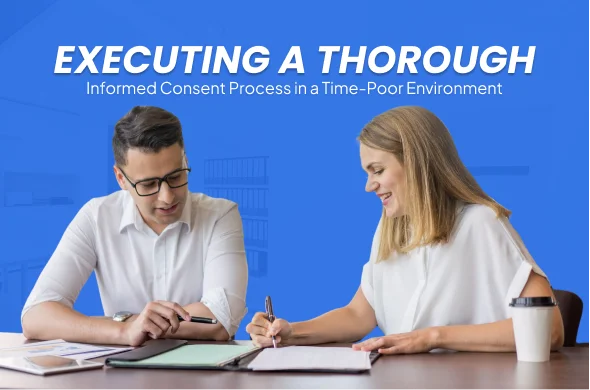
In an evidence-based healthcare landscape, allied health practitioners in private practice are under increasing pressure to execute the consent process thoroughly, effectively, and efficiently. The challenge is often founded upon a time-poor consultative environment where practitioners must ensure every step, including obtaining consent, is properly completed.
Hi! I am Andrew Arnold, founder of My Allied Health Academy. In this article, I will show you an informed consent process checklist that ensures thoroughness without compromising patient-practitioner communication or quality of treatment.
Informed consent is a vital principle in health care. It refers to consent to undergo treatment, which includes cost and number of visits. Informed consent reflects a person’s right to decide what can or cannot be done to their body and must always be given freely.
Allied health practitioners in private practice can follow the steps in this checklist to ensure their patients make informed decisions:
1. Email the New Patient Intake Form Before the Initial Visit
Send your clients your ‘new patient intake’ Form before their first appointment. This step streamlines the process and allows patients to provide all the necessary information at their convenience.
2. Include the Procedure Form
Please include the procedure form along with the intake form. This Form should outline the procedures and technique options.
3. Provide General, Easy-to-Read, Evidence-Based Clinical Information
Send general clinical information related to the techniques you offer. Ensure this information is evidence-based and easy to understand to help patients make informed decisions about their treatment.
4. Include a Short Video Introduction
Include a short video of you introducing yourself and explaining the intake process. A personal touch can help build rapport and trust before the patient enters your office.
5. Ensure Understandability
The information you provide should be clear and concise. You do not need to give the entire research paper; instead, present the key points and the references.
6. Extend the Consent Process to Include Fees and the Number of Visits.
Be transparent about the costs and expected number of visits involved in the treatment. This step sets clear expectations and helps avoid any surprises down the line. An important point here is to emphasise that any recommendations are always subject to agreement and any changes during treatment.
The client must feel empowered to participate in the treatment process right from the beginning. Highlight their safety and emphasise the choices available to them.
Suppose some aspects of your treatment protocol are generally considered outside the scope of practice for your specific modality, i.e., as stipulated by your registration board and/or professional association. Your approach may still be plausible and reasonable if the patient has been fully informed of the safety and clinical implications and provided supportive information and treatment alternatives.
Obtaining informed consent is fundamentally about providing adequate information considered reasonable by your registration board or professional association so the patient can make an informed choice about proceeding with your recommendations before any treatment begins.
Provide as much general information as possible before the consultation and then highlight the key points at the time of the consultation.
Encourage the patient to ask questions. Let them know that your role is to clearly explain the examination process, working diagnosis, and treatment plan (including estimated costs and number of visits) in a way they can easily understand.
Assure patients that there will be plenty of opportunities to say “yes, no, stop, or I need more information.” The patient must never feel blindsided or caught off guard.
Allied health practitioners in private practice must check in regularly throughout treatment. Regular check-ins are essential to provide the patient with progress markers. This helps the patient create a realistic perspective around their progress and what else needs to happen to reach their health goals.
Once you have explained your treatment rationale, the costs, and the number of visits required, it is now reasonable to ask for an agreement from the patient. Any agreements are always subject to change. However, it is recommended that the practitioner provide a treatment plan upfront rather than through a visit-by-visit review process. This creates a collaborative framework at each consultation to ensure everything is on track or needs tweaking.
As mentioned, consent is a collaborative process. The practitioner and patient clarify and agree on the destination and their optimal health goals. Only then can you both work back to a starting point and establish the steps needed to take action.
Use Web Links for Additional Information
Use web links if additional information is needed. The consent process is dynamic and always remains essential. These links may point to information on your practice website, social media page, or a third-party link that supports your treatment rationale.
Encourage your patient to introduce and share their information willingly. Always remain open to
something you may have yet to consider and consult your colleagues with more expertise if necessary.
Consent is built on communication and trust. This fosters relationships and rapport. Talk to your patients. Be honest. Ask questions. Get feedback. Are they on track, ahead of schedule or falling behind? Make it clear that while there are no guarantees, you will do your best based on your experience, clinical skills and the most up-to-date evidence-based research.
In conclusion,
A thorough consent process can be achieved even in a time-poor environment by following these steps:
1. Send forms and information through email before the patient’s initial visit;
2. Include clear, concise, and understandable evidence-based information;
3. Extend the consent process to include fees and visit expectations;
4. Emphasise patient empowerment and safety;
5. Encourage questions and regular check-ins;
6. Using web links for additional information; and
7. Stay open to new information and refer to experts when necessary.
Informed consent is not only the endpoint of the patient and practitioner’s conversation; it should imbue the entire treatment process. Implementing this checklist will help ensure your informed consent process becomes more comprehensive and efficient, which can then lead to an enhanced patient experience and higher standards of care.
So, the next time you need to obtain informed consent from a patient, consider implementing these steps. They will enhance clarity, build trust, and improve patient experiences.
For additional tips and recommendations, visit www.myalliedhealthacademy.com or sign up.
